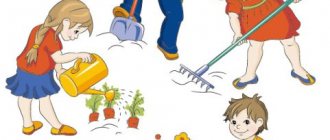In our age of impressive variety of products, the catchphrase “Not all yoghurts are created equal” also applies to toys. It is also true that a lot of toys does not mean “good”.
In this matter, as they say, “less is more”! The pages of this section contain materials on how to choose toys that are useful for a child’s development. Specific recommendations for parents will help them become more responsible when choosing toys for their children. There are also consultations on how best to organize the “communication” of children with toys, in accordance with their developmental and educational functions. Tips for organizing thematic reading competitions.
Let children play not only fun, but also usefully.
Contained in sections:
- Toys 2007
- Consultations for parents 58801
Includes sections:
- Gadgets. Harm and benefit 136
- Home theater. Consultations 79
- Games in the kitchen with children 119
- Lego, LEGO. Consultations and recommendations 147
- What to do with a child. Consultations 737
By groups:
- Junior group
Showing publications 1-10 of 9553. All sections | Toys. Consultations for parents
New
Photo
The best
Entertainment for children and parents “Games with words” Goal: to systematize children’s knowledge of all components of speech. Objectives: - education of sound culture of speech; — enrichment of the dictionary; - formation of the grammatical structure of speech; - formation of coherent speech; - development of the prosodic side of speech; - fostering love and interest in...
Consultation for parents “Geoboard is a useful toy” Consultation for parents “Geoboard is a useful toy ”
Geoboarding is one of the few fun activities that is enjoyed equally by both adults and very young children. There are a great many options for using this wonderful thing. Can't count everything...
Consultation for parents “Toys in a child’s life”
Consultation for parents
on the topic: “Toys in a child’s life”
Target
: help parents discover new opportunities for playful reflection of the world.
Tasks:
- get interested in the problem;
- give parents knowledge about the meaning of the toy, its role in the child’s play;
- equip with knowledge about appropriate pedagogical selection of toys.
Move
:
A game is a huge bright window through which a life-giving stream of ideas and concepts about the world around us flows into the child’s spiritual world. Play is the spark that ignites the flame of inquisitiveness and curiosity.
Sukhomlinsky V. A.
Preschool childhood is a period of learning about the world of human relationships. The child models them, primarily in play, which is the leading activity for him. The child spends a lot of time playing. Playing for a child is a very serious activity. As A. S. Makarenko said: “Play is important in a child’s life, it has the same meaning as activity, work, service for an adult. It is in play, free, created by the child himself, or games with rules that the child leads an active, exciting life. Play is the only form of child activity that in all cases corresponds to his organization. Most children's games involve the use of a variety of toys. (Slide No. 1)
A toy is a child’s life partner, the source of his joy. What is a toy or toys? (Slide No. 3) The main feature of the toy is that it presents in a generalized form the typical features and properties of the object, depending on which the child, while playing, reproduces certain actions. However, the meaning of toys in raising children is much broader. For each child, a toy is a creation no less grandiose than a computer and has universal human value. In addition, there is no teacher or educator in the world who is more competent and fun at the same time than a toy.
The educational value of the toy is great. (Slide No. 4)
(Section No. 5) At every age, a child needs toys that are different in theme and purpose: story toys (dolls, animal figurines, furniture, dishes), technical toys (transport toys, construction sets, etc.), tool toys (hammer, screwdriver , sweeping brush, rake, shovel, in other words, toys that imitate the simplest means of adult labor), fun toys: theatrical, musical.
(Slide No. 6) Large toys, such as scooters, children's cars, tractors, large, easily transformable construction kits, help combat physical inactivity and teach the child movements and orientation in space. Sitting at the table, it is more convenient for a child to play with small toys that are clearly visible from all sides. For games on the floor, larger toys are needed, commensurate with the child’s height in a sitting and standing position. Outdoor games in the yard require large toys; small ones are not suitable. The selection of toys is closely related to the tasks of the aesthetic and moral education of the child, with his desire for collective play, in which he uses all the toys together with all the children. When selecting toys, age-related patterns of development of play activity should be taken into account. Not all children have the opportunity to see live animals and birds. Books, toys, and television help us get to know them. (Slide No. 7) It is very important that the selection of toys contributes to the child’s formation of correct ideas about the environment. It is advisable that toys be brought into play by an adult. He interests the child in the plot of the joint game, asks him questions, encourages him to “communicate” with the new toy. “Did the doll wake up? Treat her to compote."
When offering a toy to a child, it is important to remember:
- When introducing motor toys, it is necessary to disclose their purpose and methods of operating with them.
- By presenting a figurative toy, show your positive attitude towards it, awakening the same attitude in the child. Give a name, a place where he will live. Any toy cannot be separated from the game. Children master the toy through play and accept it into their world.
- There should be no toys that depict instruments of violence, cruelty, or horror. A toy for a child is full of meaning.
All of the above toys can be classified as so-called “ready-made forms”, i.e. these toys are manufactured in a factory and they already have a functional purpose. But there is another, no less important group - substitute items.
(Slide No. 9) From an adult’s point of view, it includes completely unnecessary things, or rather garbage, but for a child this is the most valuable material for the development of imagination and creativity. These are all kinds of scraps, rags, boxes, pieces of planks or sticks, circles, fragments of something, etc. (Slide No. 
The introduction of these objects is advisable from the age of 2-3, since it is during this period that active speech develops, and substitute objects confront the child with the need to name them with a word that actually exists and is accepted in relation to a particular object. In addition, they help expand living space by introducing an imaginary situation (that wonderful “as if”!).
By the age of 4-5 years, the child begins to be most interested in all kinds of sets of families, soldiers, and animals. The child begins to come up with different options for games with them. In general, at this age, all types of toys begin to be available to the child: dolls, building materials, puzzles, attributes of professional activities, and various technical toys. Children of four to five years old carry out play actions most often with the help of toys, but their play actions can already be indicated by gesture and word. At this age, those items that in practical pedagogy are usually called attributes: all kinds of hats acquire special significance. Beads, aprons, robes. During this period, toys are needed that reflect the specifics of a particular profession. For a captain, the ship is not as important as it is important to have a telescope, binoculars, and a cap. A doctor needs a robe, a reception table, a thermometer wand, a syringe, and he certainly needs patients who patiently endure the care of the doctor and nurse. These patients may be large dolls. Sick “children” should have their own “moms” and “dads”. Gaming preferences are beginning to be divided by gender. From the ages of 4 to 7 years, children become clear that boys become men and girls become women, and this gender will not change depending on the situation or personal desires of the child. Therefore, boys choose cars and construction sets (Slide No. 9), and girls choose dolls and everything connected with them. (Slide No. 10)
(Slaytsd No. 11) But both of them continue to develop an interest in various types of mosaics and lotto, children awaken an interest in construction, that is, in those games that allow him to make something with his own hands. In addition to toys bought in the store, children’s games also include toys made by parents or the children themselves. Slide No. 12)
You say: “This is all good, but each of the listed toys costs money and not every family can afford them!” Yes, this is undoubtedly true. But it is important to remember the rule: Toys must be chosen, not collected! Naturally, you cannot help but buy some toys for your child. But if you wish, you can make all the toys yourself and they will look no less beautiful and valuable to your child than those bought in a store. Use your imagination and you will succeed. Firstly, dad can make magnificent doll furniture and a car from scraps of wood; secondly, mom can sew a magnificent doll and clothes for it from leftover yarn or fabric; thirdly, lotto and puzzles can be cut out from newspapers and magazines. . On the one hand, this is budget savings, and on the other hand, it is a good opportunity to unite the family.
(Slide No. 13) Cultivate a caring attitude towards the toy. Try to gradually teach your child to maintain order among his toys - first of all, by your own example. Start cleaning and ask your baby to help you. Explain that each toy should have its own house. Praise works better than blame: praise your child every time he puts the toy back in its place. Convenient cabinets, beautiful boxes - all this will help instill in your child a love of order in the nursery, and later - of order in the house. Correct guidance of the game by adults makes it meaningful, truly leading in preschool age, and significantly expands the child’s horizons.
So, from an early age, a child has a need for play and toys, and our task, dear parents, is to satisfy this need, because while playing, the child learns and experiences life. Game and toy are inseparable from each other. A toy can give rise to a game, and the game, sometimes, requires a new toy for development. Toys can be very diverse, but they all must meet certain pedagogical, artistic and aesthetic requirements, so at least adults need to take the choice of toys very seriously. If you want to buy your child a new toy, follow 4 rules. (Slide No. 14)
In conclusion, it is necessary to remind you, dear parents, that no toy, even the best toy, can replace live communication with your beloved dad and mom! (Slide No. 15)
Educational games for children. How to help your child grow up cheerful and happy
The baby experiences special pleasure from moving in space - crawling or walking. He likes the process itself, although the process is not without certain difficulties and troubles; the child may get tired, fall and hurt himself.
Therefore, the baby perceives with particular pleasure such educational games in which crawling, or walking, or some important elements of these actions are reproduced in a lighter and safer, but accelerated or intensified form.
Place a towel or folded blanket under the belly of the child lying on the carpet. Lift him up so that he is in a crawling position and rock him back and forth a little. Hold him so that he can crawl easily, and from time to time lift him into the air and carry him forward a short distance. The main ability that a child must develop when learning to walk is the ability to maintain balance. You can help him with this. Place your baby on your lap, spread his arms to the sides and hold them. Alternately raise one or the other knee, so that the child leans first to the right, then to the left. Help your child maintain balance by holding his hands. Raise and lower your knees to the beat of the music. You can put on a record, or turn on a tape recorder, or sing yourself, the main thing is that the music is cheerful. Place the child in front of you, facing you, and take his hands. Begin to slightly tilt it to the right, then to the left, moving its center of gravity from one leg to the other. Sing a song so that the child sways to the rhythm of the song. Keep your child's arms at shoulder level or even lower. Gradually reduce your support so that your baby continues to rock on his own. Let him then hold only your index fingers with his hands. Make his arms drop down and be positioned almost vertically on his sides. Try swaying to the rhythm of the song yourself. This will stimulate the child - he will try to imitate you. Place your baby's feet on your legs with his back to you. Hold him by the shoulders. Say, “Come on, let's go,” and walk a short distance. Look how he reacts to this game. If he likes it, repeat it on different days. Let other family members, including older children, do this for you. Such a game helps strengthen contact between a child and an adult and is useful from this point of view. If the baby does not express pleasure in the game, put it aside and try again after some time.
Teach your child to “sing” to the music. Turn on the tape recorder, or player, or radio. Sing yourself, using those syllables (“mama” or “dada”) that the child can easily pronounce. Invite him to join you. Repeat this game many times until he begins to sing to the music on his own. Continue playing “Peek-a-boo, where am I?” with your child. First, cover the child’s eyes with your hands and exclaim: “Where is Misha, where did he go?” Having removed his hands, rejoice: “Misha is here!” Then teach the child to cover his eyes with his hands and wait for your exclamations: “Where has Misha disappeared?” Express delight when he removes his hands from his face. You can also teach him to cover his face with a napkin or diaper, and then pull it off
Your joy when the napkin is pulled off or the hands are removed from the eyes will contribute to the emotional development of the child. At this age, the child begins to understand how to attract or maintain the attention of an adult - and begins to repeat actions that made others laugh. You can support and develop this behavior in him by participating in a variety of games with him.
For example, play with your child “A horned goat is coming for the little guys, gores, gores, gores, gores,” where first you portray this goat, and then he. Be scared when the child reaches out his hand in your direction, and then start laughing.
How do I prepare for consultations?
I plan consultations for the entire academic year, so I decide on topics in advance and select material for the conversation. Of course, I look for information in my favorite online store “UchMag”.
There are such manuals on our topic:
- “Interaction with the child’s family. Planning interaction with families of pupils for the year. Senior group from 5 to 6 years old: parent meetings, consultations, reminders for parents, family holidays. Set of 16 double-sided cards";
- “Interaction with the child’s family. Planning interaction with families of pupils for the year. Preparatory group (from 6 to 8 years): parent meetings, consultations, reminders for parents, family holidays.”
By the way, I recommend watching a video from the publishing house teacher on family education and teaching children.
It would seem, what problems can arise from children's toys? But no, inquisitive and thoughtful mothers and fathers understand that this is a very serious question that requires clarification.
Playing with rattles
In general, everyone knows about the usefulness of rattles. Therefore, I will mention only a few important points that are useful to know.
In order for a newborn baby to learn to focus his gaze on a rattle, it is important to show it at a distance of approximately 25-30 centimeters from the baby’s eyes. In the 1st and 2nd months of life, this distance is optimal both for communicating with the baby and for showing him toys
This is explained by the fact that due to the immaturity of the eye muscles, the baby sees blurredly at a further distance, and it is still difficult for him to focus on a distant object.
While showing the rattle and making sound from it, smoothly move it to the right and then to the left. In this way, you will improve your baby’s visual and auditory orientation. And already at the age of 10 days you will notice that the baby has begun to follow the moving rattle with his eyes.
Starting at about 3 months, you can begin to work on the grasping movement of the hand. And here rattles on a stick will come in handy, which will be convenient for the baby to hold with one hand. First, you will need to help the baby and put the toy in his hand, and closer to 4 months, he will learn to independently take the rattle from your hands and hold it.







